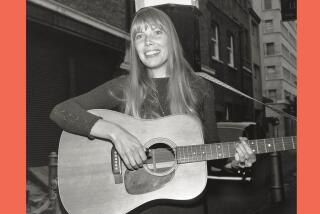In ‘mercy,’ Looking for Truths in Human Nature
Two and half years ago, in a Westside synagogue, Meredith Monk sang to the Dalai Lama, who was on hand to give a talk. She stood before him and welcomed him with an invocation, making distinct music in her wordless, elemental manner that seems to come directly out of her body and being. She beamed. He beamed. Before long, the large temple seemed aglow.
A few months later, Monk returned to the Southland to present her sci-fi opera, “Magic Frequencies.” It began with Monk and a member of her company seated across a kitchen table, singing a loopy duet. She beamed. He beamed.
Once again, it wasn’t long before the joint was spiritually jumping, this time attracting the attention of adorable aliens from outer space.
Thursday night at UCLA’s Royce Hall, Monk once again began a new piece sitting at a table across from a partner, singing, beaming. Her companion was the noted installation artist, Ann Hamilton, who beamed a light into Monk’s mouth as she intoned a drone. A miniature camera, attached to Monk’s teeth, then beamed the inside view of chanting lips onto the large screen that served as the backdrop of the stage. No holy men, no aliens beckoned. Instead, the beaming in “mercy,” the new collaborative work from Monk and Hamilton, called forth essential questions of our own spirituality, and about what is true and what is alien in human nature.
The 83-minute performance piece, which had its premiere last summer in Durham, S.C., comes without explanation. In interviews, the two artists have described the inspiration for “mercy” as an attempt to come to terms with the incomprehension they felt when they watched on TV the shooting of a Palestinian boy, caught in cross-fire on the Gaza Strip, neither side acknowledging his father’s pleas for mercy. It is a horrific image, but one we don’t see or need to know about. There was no reference to it in the work, and the program came without notes.
Instead, what this intensely moving, drop-dead gorgeous, can’t-be-categorized fluid piece of meditative music, movement and milieu presents is an immersion into the process of transcendence. And what is truly remarkable is that it does this in many unrelated ways that all somehow interlock.
One example of many occurs near the beginning. Hamilton, still at the table, trains her minute camera on her fingertip, as she draws a line with a pencil, across an unfurling bolt of paper. The entire backdrop of the stage, then, is magnified pencil lead and flowing line, a beautiful image of rippling movement, a road endlessly expanding.
Meanwhile, Monk moves away from the table, her chair slowly gliding backward, her music following repetitious cycles that slowly evolve in their own directions. The counterpoint of different kinds of movement is hypnotic.
Not everyone would have predicted a success from the collaboration of Monk and Hamilton. However compatible their sensibilities may be, they are both incredibly strong artists who create complete worlds. Monk--a composer, choreographer, singer, dancer, myth maker and what not--is the model of a poly-artist with an all-encompassing vision. Hamilton’s immense, overwhelming installations are vast landscapes, such as the facade she created for the new main library in San Francisco with 50,000 3-inch-by-5-inch annotated cards.
But beyond their inevitable ornate grandiosity, Monk and Hamilton often work on a downright primordial level. And together, they avoid competition by keeping everything simple and pure. In “mercy,” Monk creates her typically direct images of human contact and feeling with her eight-member company of singers, musicians and dancers.
In one scene a doctor (Theo Bleckmann) slowly approaches Monk, his voice jumping between baritone and falsetto. He examines her. They sing nonsense syllables, but unmistakably deep feelings, the kind for which words can seem inadequate, are expressed.
Over and over, such feelings emerge. There is the shock of the doors of the theater opening, bright lights shining and a chorus of over-coated refugees walking past us, inserting the audience into some kind of exodus.
Hamilton’s additions to Monk’s evocations are equally arresting, her miniature camera creating landscapes of the human face, the written word.
She bathes the stage in glorious color. As Lanny Harrison dances, a scrim is lowered , turning the luminous screen behind her into living moire patterns. There is sheer magic in the scene in which Hamilton makes Monk’s syllabic song visible by causing the breath of two singers to release bubbles from watery curtains.
Near the end, Hamilton’s camera focuses on a page of text. Words appear out of context, but one sentence survives. Ogres, it says, are also people, but inhuman. Then a simple, radiant wordless song from five singers in a circle; behind them a mouth large and spooky illuminated on the screen. I can’t tell you why, but at that moment, after much grave, earnest, disquieting beauty, the quality of “mercy” seemed the essence of humanity.
More to Read
The biggest entertainment stories
Get our big stories about Hollywood, film, television, music, arts, culture and more right in your inbox as soon as they publish.
You may occasionally receive promotional content from the Los Angeles Times.











